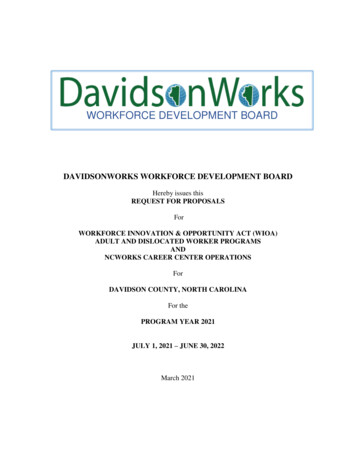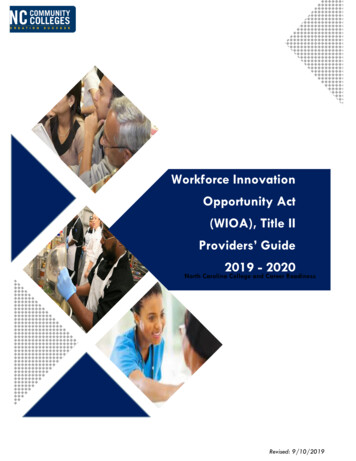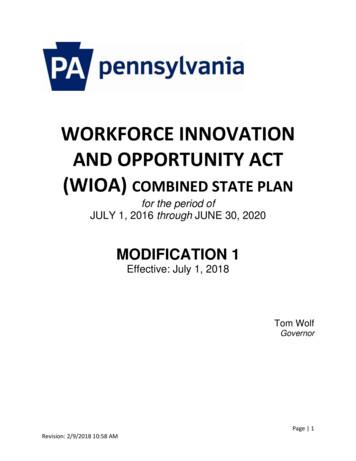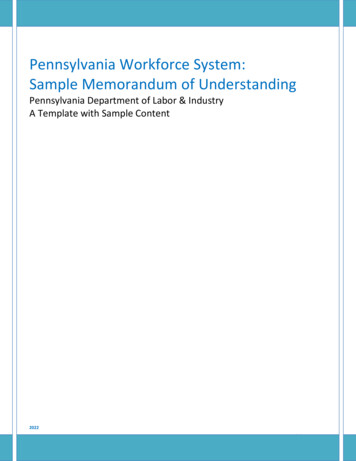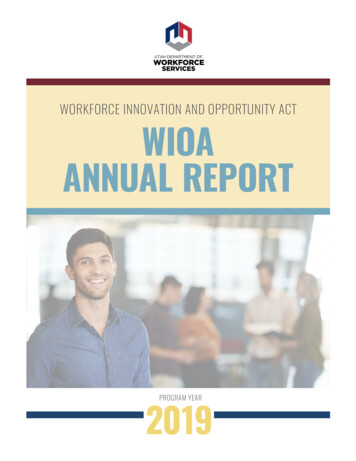
Transcription
WORKFORCE INNOVATION AND OPPORTUNITY ACTWIOAANNUAL REPORTPROGRAM YEAR2019
CONTENTSSTATE PLAN. . . . . . . . . . . . . . . . . . . . . . . . . . . . . . . . . . . . . . . . . . . . . . . . . . . . . . . . 3CAREER PATHWAYS . . . . . . . . . . . . . . . . . . . . . . . . . . . . . . . . . . . . . . . . . . . . . . . . 4STRATEGIES FOR BUSINESS ENGAGEMENT. . . . . . . . . . . . . . . . . . . . . . . . . 8EFFECTIVENESS IN SERVING EMPLOYERS. . . . . . . . . . . . . . . . . . . . . . . . . 10STATEWIDE ACTIVITIES . . . . . . . . . . . . . . . . . . . . . . . . . . . . . . . . . . . . . . . . . . 11PERFORMANCE MEASURES. . . . . . . . . . . . . . . . . . . . . . . . . . . . . . . . . . . . . . . . 17EVALUATION PROJECTS. . . . . . . . . . . . . . . . . . . . . . . . . . . . . . . . . . . . . . . . . . . 18CUSTOMER SATISFACTION MEASURES. . . . . . . . . . . . . . . . . . . . . . . . . . . . 20WAIVERS. . . . . . . . . . . . . . . . . . . . . . . . . . . . . . . . . . . . . . . . . . . . . . . . . . . . . . . . . . 21SUCCESS STORIES. . . . . . . . . . . . . . . . . . . . . . . . . . . . . . . . . . . . . . . . . . . . . . . . . . 22ATTACHMENT A. . . . . . . . . . . . . . . . . . . . . . . . . . . . . . . . . . . . . . . . . . . . . . . . . . . 25ATTACHMENT B. . . . . . . . . . . . . . . . . . . . . . . . . . . . . . . . . . . . . . . . . . . . . . . . . . . 30ATTACHMENT C. . . . . . . . . . . . . . . . . . . . . . . . . . . . . . . . . . . . . . . . . . . . . . . . . . . 32ATTACHMENT D. . . . . . . . . . . . . . . . . . . . . . . . . . . . . . . . . . . . . . . . . . . . . . . . . . . 34ATTACHMENT E. . . . . . . . . . . . . . . . . . . . . . . . . . . . . . . . . . . . . . . . . . . . . . . . . . . 35ATTACHMENT F. . . . . . . . . . . . . . . . . . . . . . . . . . . . . . . . . . . . . . . . . . . . . . . . . . . 36Equal Opportunity Employer/ProgramAuxiliary aids and services are available upon request to individuals with disabilities by calling 801-526-9240. Individuals who are deaf, hardof hearing, or have speech impairments may call Relay Utah by dialing 711. Spanish Relay Utah: 1-888-346-3162.2
STATE PLANUTAH’S STATE WORKFORCE Developmentfrom the core partners and an economic update fromWorkforce Services. The sub-committees and partnersutilized this information to inform the development ofthe 2020-2023 WIOA plan.Board, along with agency, community, education andbusiness partners developed its 2020-2023 state planduring Program Year 2019 (PY19). The process involvedpresenting a draft to stakeholders and the general publicat town hall meetings throughout the state. The plan wasapproved by federal partners. The full plan, including anexecutive summary can be viewed at this link: jobs.utah.gov/wioa/wioastateplan.pdf.The Apprenticeships Committee supported theApprenticeship Job Fair during National ApprenticeshipWeek including the first industry and education breakfast.The committee has maintained content for the Utahapprenticeships website, which provides information foremployers and job seekers. The committee supportedpartner initiatives such as training career and technicaleducation counselors on apprenticeships, involving moreemployers on the committee and coordinating on grants.The committee supports the goals and objectives of thestate’s Apprenticeship State Expansion Grant, ensuringgrant progress and needs are discussed at each committeemeeting. The committee also contributed to the stateWIOA plan ensuring its goals align with the plan.As the new plan was being developed, Utah continued toimplement its current plan.Utah’s State Workforce Development Board certifiedthree Comprehensive One-Stop Centers. The certificationprocess includes partner agency management meeting,training all partner staff to ensure they are familiar with allthe services and resources available, the board’s review ofthe center to ensure customers have access to high qualityservices from all Workforce Innovation and OpportunityAct (WIOA) partners and the center’s commitment tomeeting at least two times per year for continuous servicealignment and coordination improvement.The Career Pathways Committee members regularlyshared information and proactively supported variousprojects and initiatives across the state that benefitbusiness needs as well as help students and job seekersachieve their goals. The committee facilitated discussionsrelated to improving alignment, connections, and fillinggaps among agency, education and community programs.The committee developed actionable goals for the StateWIOA plan.Utah’s State Workforce Development Board is the onlyboard in the United States to partner with governmentagencies and community organizations to participate ina statewide partnership service project. In January 2020,Utah’s workforce development partners came together togather food products to create Pantry Packs for K-12 schoolchildren to have access to meals during the weekend.The State Workforce Development Board supported thedevelopment of the WIOA Partner Memorandum ofUnderstanding, Infrastructure Funding Agreement andthe One-Stop Operator Memorandum of Understandingand approved them.The Operations Committee oversaw the certification ofthe Midvale, Spanish Fork and Lehi Comprehensive OneStop Centers. The committee continued to evaluate thejob seeker survey implemented in 2019 and initiated anew business customer survey. In addition, the committeeled the development of the recertification process for onestop centers and contributed to the WIOA plan.The State Workforce Development Board receivedinformation on available performance measures dataThe Services to Individuals with Disabilities Committeesupported the Golden Key Awards, which recognizes3
businesses that hire and support individuals withdisabilities. The committee continues to work closelywith Utah’s Business Leadership Network to help improveworkplace opportunities for individuals with disabilities.Several mentoring events for students, the Work AbilityFair, and presentations for employers were implementedby this committee. The committee reviewed the goals inthe state WIOA plan to ensure they are incorporated intothe committee’s work.partners came together to provide support to impactedindividuals and businesses. During this time, it becameclear that the primary goals of the Utah plan demonstratethe actions needed for almost any situation. These goalsinclude:The Youth Committee has been working with a groupof students who will contribute to the development ofshort workshop videos that will help youth understandhow to get and keep a job. The goal is to create videosthat support concepts partners are currently teachingyouth. The committee promotes engaging employers inwork-based learning activities and helping youth connectwith those opportunities. Committee members utilizemeetings to share information with one another to ensurealignment and collaboration. The Youth Committeeincorporated its goals into the state WIOA plan.Utah’s plan was in its approval process as the COVID-19pandemic began to impact the world. As events related tothe pandemic began to unfold, Utah’s workforce system A focus on partnering Involving employers directly in the workforcedevelopment system Establishing education and training programsthat meet both the current and emerging needs ofbusinesses and organizations Providing education and training options thatprovide the skills and competencies required tomeet employer and job seeker needs Leveraging and aligning resources to reduce oreliminate barriers to employment so that at-riskpopulations have greater opportunities in theworkforce.All agency core partners coordinated to contribute to thedevelopment of this report including the inspirationalsuccess stories.CAREER PATHWAYSUTAH’S WORKFORCE SYSTEM relies oncommittees to ensure coordination and alignment withthe board and Utah’s WIOA plan.a variety of strategies to implement effective careerpathways that can meet individual needs. The StateWorkforce Development Board and its partners worktogether to ensure coordination and communication ofthese efforts.Talent Ready Utah grants have been designed tostrengthen collaboration between industry, education andeconomic development to better respond to the needs ofregional and statewide high-growth, high-wage STEMoccupations and industries. Talent Ready Utah has beena successful model for industry collaboration and hasdemonstrated success in developing new educationalprograms and aligning existing programs to supportindustry growth.TALENT READY UTAHTalent Ready Utah is a collaborative partnership betweenthe Governor’s Office of Economic Development,Workforce Services, the Utah System of HigherEducation, the Utah System of Technical Colleges, theUtah State Board of Education, the Salt Lake Chamberand industry partners. Talent Ready Utah partnersparticipated on State Workforce Development BoardThese grants were used to develop Career Pathways thatbegan in high school, linked to post-secondary educationand provided concurrent enrollment when possible.4
Pathways for adults were also developed as appropriate.This included the development and expansion of theUtah Aerospace Pathway, Medical Innovations Pathway,Diesel Tech Pathway, Architecture, Engineering andConstruction Pathway and the Utah Rotor Pathway.Funding for this program was derived from theUnemployment Insurance Special AdministrativeExpense Account.in employment internship opportunities gain soft andoccupational skills required for the job. The on-the-jobtraining program is offered to both youth and adult jobseekers. The purpose of this program is to help job seekerswho either have the educational background, but lack thenecessary work experience for the job, or who lack boththe credential and the experience. They receive on-thejob training and remain employed with that employerafter completion. The program is a great opportunity forjob seekers to get back into the workforce, increase theirskill sets, and move into self-sufficiency. By using anindividualized work experience placement strategy foreach adult and youth job seeker, Workforce Services helpsbroker a productive employer-employee relationshipthat will help each customer on their way to a successful,meaningful career.MEDICAL INNOVATIONS PATHWAYWorkforce Services joined members of the MedicalInnovations Pathway Program to discuss the outcomesfrom the 2019-2020 school year and the impact COVID-19had on the participants in the program. The MedicalInnovations Pathway Program offers specialized coursesand practical work experience to help students developskills needed by Utah’s most elite medical device andlaboratory testing companies. In order to comply withsocial distancing protocols, a virtual graduation was heldfor the 12 students who completed the Medical InnovationsPathway Program. Despite straying from the normalgraduation process, all agreed the virtual ceremony was ahuge success. As COVID-19 continues to affect daily lives,program directors continue discussing ways to continue theprogram while keeping participants safe.Despite the economic disruption caused by theCOVID-19 pandemic, Utah still managed to assist129 youth and adult job seekers with at least one workexperience opportunity in PY19. Work experienceconnections made in the Mountainland economicservice area were driven by the outreach from workforcedevelopment specialists to employers and othercommunity stakeholders. Workforce Services counselorsworked directly with workforce development specialiststo connect job ready customers with employmentopportunities that aligned with their employment andcareer goals. Coordinating with local partners such as thetechnical college, county jail, alternative high schools andemployers led to many positive outcomes. The examplebelow illustrates how these collaborative efforts resultedin a success for everyone involved.WORK EXPERIENCEUtah continues to utilize work experience to assist youthand adult job seekers in acquiring occupational skillsneeded to obtain suitable employment. The Youth andCareer Pathways Committees assist in coordinating effortsto promote and expand work experience opportunities foremployers and job seekers. The committees’ members andcore partners collaboration has contributed to buildingrelationships with employers in local areas and developingcontracts with new employers; providing outreach toemployers to expand work experience opportunities forindividuals with disabilities; and increasing engagementwith technical colleges to educate on work experienceprograms provided by partner agencies.Steven first heard about Workforce Services’ on-the-jobtraining and bonding programs at the Utah County jail,where a Workforce Services counselor and a workforcedevelopment specialist presented at the “90 Day Out”county program. When Steven was released, he wentto Workforce Services for assistance with career andeducation services. Through individualized careercoaching services, he was placed in an on-the-jobtraining position that paid 14 an hour. He successfullycompleted this work experience opportunity and wasoffered a promotional opportunity to become a qualitycontrol foreman. His pay increased to 20 an hour withthe added benefit of a company truck. The partnershipbetween the agency and employer, along with Steven’sWorkforce Services offers two different types of workexperience opportunities. The youth employmentinternship opportunity program provides youth withpractical career exploration through short-term workexperience exposure while allowing them to earn wagesat the same time. Additionally, youth who participate5
good work ethic, led the employer to become a RegisteredApprenticeship sponsor on Utah’s Eligible TrainingProvider List. Steven is now waiting to start an HVACapprenticeship. The employer stated that because ofSteven’s work ethic and positive attitude, he is willing tocontinue partnering and providing work opportunities toinmates from the “90 Day Out” program.Linda’s recent experience did not lend to keeping up todate with the latest technology, so she was strugglingto be competitive. The Workforce Services counselorsuggested on-the-job training as a way to acquire thelatest technology training that would build on the skillsshe currently possessed and benefit her long term. Basedon her past experience with software sales for Microsoftcontractors, the workforce development specialist wasable to develop an on-the-job training opportunity fora software sales position for Linda. She was trained invarious new software programs providing her with skillsthat could transfer to other employers in the industry andbecame a valuable addition to their sales team.Utah’s core, industry and education partners have workedtogether across the state to develop work experienceopportunities for the participants. Below are examplesshowing how work experience was used to assist withcareer advancement and as a valuable career coachingtool, opening the job seeker’s eyes to the possibilities theymay have not considered.Michael is 19 years old. He has attention deficithyperactivity disorder, is partially deaf and dropped outof school in 12th grade. When he came to WorkforceServices, his goal was to further his education and finda career that would meet his needs. Michael was veryinterested in the general laborer position and started ayouth employment internship opportunity in that field.During his work experience, Michael attended adulteducation classes and Workforce Services providedadditional supportive services, such as funds for hiswelding helmet and eye glasses. The employer was soimpressed with Michael’s commitment and progress thatthey hired him for a full-time position.Through a comprehensive career assessment, a WorkforceServices counselor and Judy, a TANF (TemporaryAssistance for Needy Families) participant, concludedthat to achieve her goal of a career in web development,she would need to obtain additional education. Afterreviewing options for the additional training, theydecided on the web development program at a localcollege. Unfortunately, Judy was lacking recent workhistory in the field for acceptance and admission intothe program. She met with a workforce developmentspecialist and they identified some potential unpaidworksite learning locations where she could obtain theexperience. With assistance from the Workforce Servicescounselor and workforce development specialist, Judysecured an on-the-job training opportunity where sheworked 20 hours per week at 18.50 an hour as a webspecialist. With this additional experience, she obtainedthe skills and work history she needed to be accepted intothe web development program. Judy’s increased incomeended her TANF benefits. To continue supporting hertraining and work experience, Judy’s Workforce Servicescounselors helped her enroll in the WIOA Adult program.Workforce Services is exploring opportunities for Utahto implement transitional jobs and incumbent workerprograms to further support target populations with workexperience opportunities.LIFTING DISABLED YOUTHTHROUGH CROSS-AGENCYPARTNERSHIPAssisting populations with barriers to employment is apriority for Utah Workforce System partners. Engagingyouth in work activities prior to graduation from highschool is paramount for success in the workforce.Workforce Services, Utah Division of Services forPeople with Disabilities, and the Utah State Boardof Education collaborate to improve employmentopportunities for youth through the School to WorkProgram. This program offers transition age youth (1422) with intellectual and developmental disabilitiesan opportunity to explore careers through workLinda had been working in sales for a long time andfelt like she was constantly being laid off. She wantedto change to a career with more stable employment.She requested assistance with training in culinary arts.Linda and her Workforce Services counselor reviewedher financial needs and the labor market informationfor culinary arts. They determined that this was notthe best option for her. In discussing Linda’s previouspositions, the Workforce Services counselor found that6
APPRENTICESHIPS AND WORKBASED LEARNINGexperiences prior to graduation. The team includes theschool teacher, youth and family, Division of Servicesfor People with Disabilities, job coach, WIOA Youthcounselor and vocational rehabilitation counselor.The team meets monthly to coordinate activitiesthat assist the youth with goal development and skillacquisition in preparation for employment. Experiencesare tailored to the youth’s interests and individualneeds. Job experiences have included opportunities inmanufacturing, retail, service, construction and tradesand technology industries. This experience preparesyouth for competitive, integrated employment by thetime youth exit the secondary school system.Building partnerships to promote apprenticeships andwork-based learning was an essential activity duringPY19 for Utah. The Apprenticeship Sub-Committeeof the State Workforce Development Board assistedwith developing policies for the ApprenticeshipState Expansion grant, identifying system needs andserving as a voice for apprenticeship in Utah. The UtahCommissioner of Apprenticeship, appointed throughthe 2019 Utah legislation, is an important partner.The commissioner’s efforts in identifying the currentapprenticeship landscape in Utah, maintaining contactwith key stakeholders and collecting data helps furthergrant activity and fill data gaps. The Utah State Board ofEducation is also an essential partner to achieve successin youth apprenticeship. Utah has two other Departmentof Labor grants focused on apprenticeship. Coordinationbetween administrators of these grants occurs regularly toensure mutual goals are shared and supported.The following success story highlights Tate’s experienceas a student in his last year of post high school services.Tate’s support team includes his paraeducator from posthigh, vocational rehabilitation counselor, WIOA Youthcounselor and job coach. His team worked togetherto coordinate services for a full range of support for acommunity integrated employment opportunity. Tatetook an assessment to determine his strong interestand necessary skills leading to a job experience inexotic animal care. His WIOA Youth counselor and theemployment specialist worked together to set up aninternship at a locally-owned reptile shop. The businessowner and supervisor provided Tate with differentjob tasks and identified the job task that needed tobe completed that closely matched Tate’s abilities andinterests. During the internship, Tate completed the jobresponsibilities with the assistance of his job coach andworked to complete tasks independently. The employeroffered him a permanent position. His experience onthe job site demonstrated that he was able to completetasks above and beyond the expectations of his family,educators and service providers. Tate’s job is meaningfulto him and his work is highly valued by his employerand coworkers.The Utah Federal Office of Apprenticeship registers allRegistered Apprenticeships Programs. Currently, thereare 234 apprenticeship sponsors registered with the Officeof Apprenticeship, 21 were new in PY19. The Office ofApprenticeship indicates that Utah currently has 4,115apprentices in registered apprenticeship programs,1,161 were new in SFY 2020. During PY19, there were145 active female apprentices (3.5 percent of the total)compared with 3,983 males. This is a slight increase inrepresentation for women from the prior year. From May2019 to May 2020 the number of individuals declaringthemselves as veterans increased from 184 individuals to387, which is a 110 percent year-over increase.Utah is experiencing success in working with existingcareer pathway programs to expand work-based learningapproaches including apprenticeship. In PY19, theArchitecture, Engineering and Construction Pathwaywas launched. This partnership was led by AssociatedGeneral Contractors and Weber State University andwas funded through a Talent Ready Utah grant fromWorkforce Services. Through concurrent enrollment highschool students can take courses in areas that will lead toa degree and internship opportunities. The Architecture,Engineering and Construction Pathway groupincludes representation from industry, education andThrough these opportunities, Workforce Serviceshas found that youth have an opportunity tobuild confidence and work skills while increasingindependent skills and exposure to career paths.Workforce Services, coordinating and aligning withworkforce system partners, will continue to provideopportunities for youth to engage in activities inpreparation for employment.7
government. It is working to include apprenticeships aspart of the pathway. When a Department of Labor YouthApprenticeship Readiness grant became available, theefforts of the Architecture, Engineering and ConstructionPathway group were leveraged to apply. Although theSTRATEGIES FORproject was not awarded, Utah will explore other optionsto connect these efforts to the Apprenticeship Expansiongrant during PY20.BUSINESS ENGAGEMENTENGAGING BUSINESS PARTNERS,in both counties, to facilitate a virtual “employerrecruitment.” Workforce Services marketed the eventand ensured staff at PeopleReady would be able to meetvirtually with job seekers. During the online recruitmentevent 20 job seekers met with PeopleReady staff remotelyand explored employment opportunities. PeopleReadyexpressed excitement with the results and is readyto partner with the Workforce Services for furtherrecruitment opportunities.determining their needs and finding solutions hasalways been a priority in Utah. Utah’s WIOA planclearly demonstrates this in its goals and strategies.Workforce system partners have been building onexisting partnerships as the plan has been successfullyimplemented during the past four years.Workforce Services employs skilled workforcedevelopment specialists whose main goal is to reach out,engage and support Utah employers. Since there are over113,000 employers in the state, workforce developmentspecialists are adept at working with those in their localareas, meeting with them individually and educatingthem on Workforce Services. They endeavor to determinethe individual employer’s workforce needs and provideinsight and solutions to support them.Workforce Services, along with other workforce systempartners, have supported state and local economicrecovery efforts during the pandemic and economicdownturn. For example, Workforce Services providedvaluable resources, unemployment data and industrysupport for several economic recovery task force groupsincluding the Salt Lake Chamber of Commerce which isthe largest Chamber of Commerce in the state. Supportwas also provided to employers that reached out tothe Employer Initiatives Division requesting guidanceand information regarding furloughs, unemployment,reducing employee hours, etc. Virtual meetings wereheld with business owners and their employees toexplain their benefits.Workforce development specialists are an integral part ofassisting employers in meeting their workforce needs. Animportant way they have supported employers this yearis by educating and recruiting them to be part of monthlystatewide virtual job fairs. Workforce Services purchasedthe rights to the Easy Virtual Job Fair platform and hasoffered it to Utah’s employers at no cost. WorkforceServices promotes this service to all employers. Beginningin April 2020, the virtual job fairs have averaged 100employers and 800 job seekers at the monthly events.This has been a valuable resource to businesses that arethriving during the pandemic but finding it difficult torecruit with the social distancing restrictions.In response to COVID-19, virtual meetings were heldwith industry associate presidents and their leadershipteams to introduce them to available WorkforceServices resources during this unprecedented time.Unemployment insurance, TANF, WIOA, WorkforceResearch and Analysis and Employer Services staffattended. These meetings led to industry associationsreaching out for assistance from Workforce Services.Workforce Services staff from Carbon and Iron Countypartnered with PeopleReady, a business with locations8
UTAH WORKSuses his apprenticeship program was invited to speakabout his experience and the Office of Apprenticeship.After several follow up conversations, six of the programsin attendance were registered.Workforce Services partners with the Utah WorksProgram managed by the Talent Ready Utah Centerof the Governor’s Office of Economic Development todrive partnerships between businesses and educationalinstitutions to create short-term, new-hire trainingprograms to address high demand company identifiedworkforce gaps. Grant funding is used in collaborationwith cost sharing efforts from the partners to: createtraining curriculum, procure tools and training resources,reimburse tuition or faculty salaries, support programmarketing and fund other efforts that directly support thetraining program requirements.COVID-19 has delayed the development ofapprenticeship programs for many large employers as theyare trying to better understand their budgets and focustheir attention on the health and safety of their employees.The Apprenticeship Expansion grant has provided anincentive for many employers to try out apprenticeships.This grant allows for the payment of on-the-job trainingfunds to employers participating in registered programs.During this time of economic uncertainty, employers arebecoming more interested in the funding to allow themto continue to develop apprenticeship programs for theirworkforce.APPRENTICESHIP EXPANSION GRANTOver the course of the year strong partnerships havebeen developed with employers seeking to createapprenticeship programs and employers who have notactively used their apprenticeship program in some time.The manager of the Apprenticeship Expansion granthas assisted employers who are interested in developinga program through the registration process to facilitatethe registration of new programs. Employers are assistedwith identifying the occupation they wish to register,reviewing existing work processes and connecting withthe Office of Apprenticeship to be registered. Onceregistered, programs must track data, provide mentoringand market their programs. The grant manager supportsthese new programs by connecting them to sponsors whohave long-term programs and can assist new sponsors inovercoming challenges.Over the program year, several employers and industryassociations were interested in participating in registeredapprenticeships but were hesitant to register and workdirectly with the Office of Apprenticeship due to beingtoo small and lacking the infrastructure to manage theirown programs. Workforce Services provided strategiesto connect these employers to intermediaries. As anexample, Workforce Services successfully facilitated twonew intermediary sponsors in registering programs withthe Office of Apprenticeship. In addition, partnershipswith industry associations and union intermediaries havebeen leveraged to refer employers who may be interestedin using their programs for apprentices.MARKETING APPRENTICESHIPSUtah’s Eligible Training Provider List is usually the firstplace job seekers are directed to find a program whenthey are working with a Workforce Services counselor.Enhancements were made to Utah’s labor exchangesystem this year so that when existing sponsors andemployers post apprenticeship openings on jobs.utah.gov,the opening will display on the Eligible Training ProviderList.Workforce Services has a strong relationship with severallocal media outlets enabling Utah to increase publicawareness of apprenticeships. When a local news outletwanted to do a story on helping people to get back towork during COVID-19, they reached out to WorkforceServices. Workforce Services shared resource
Steven first heard about Workforce Services' on-the-job training and bonding programs at the Utah County jail, where a Workforce Services counselor and a workforce development specialist presented at the "90 Day Out" county program. When Steven was released, he went to Workforce Services for assistance with career and education services.

